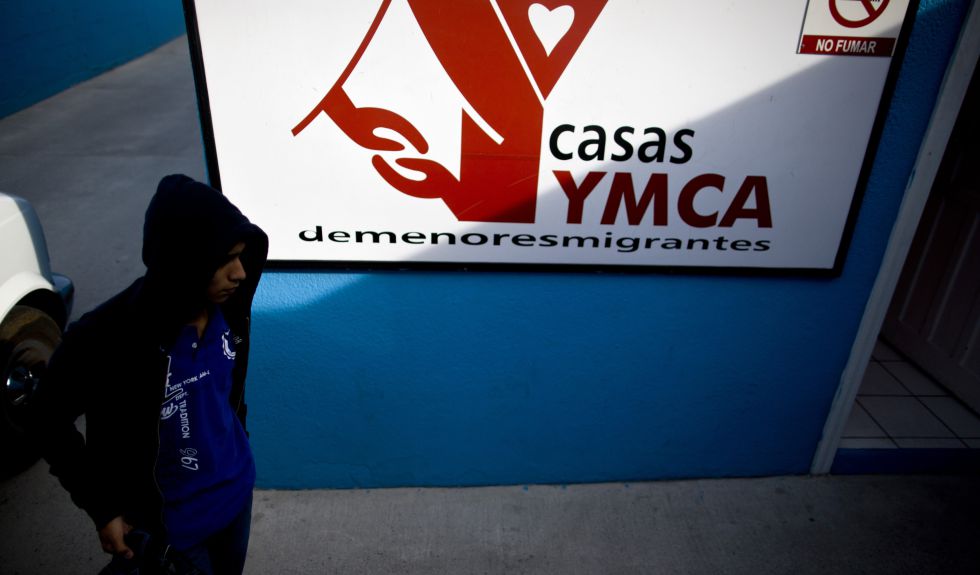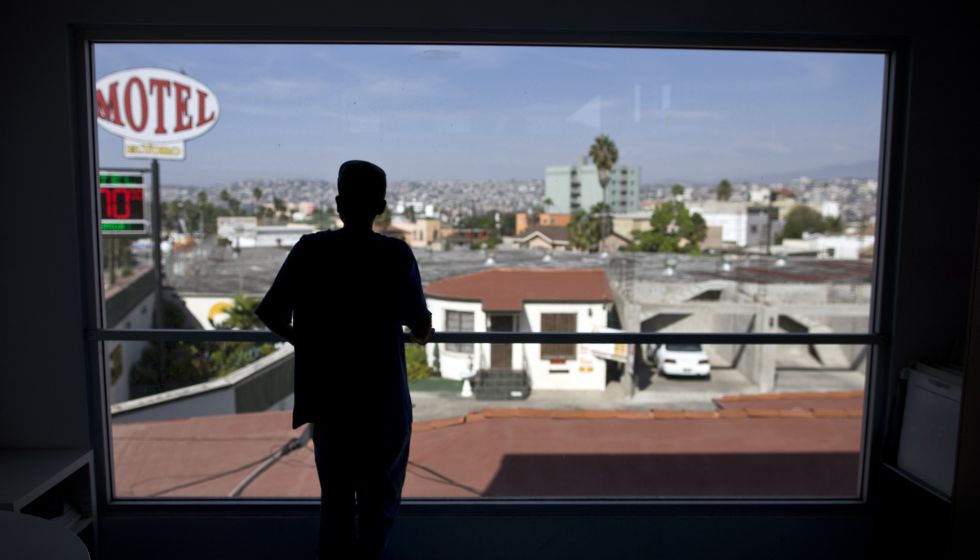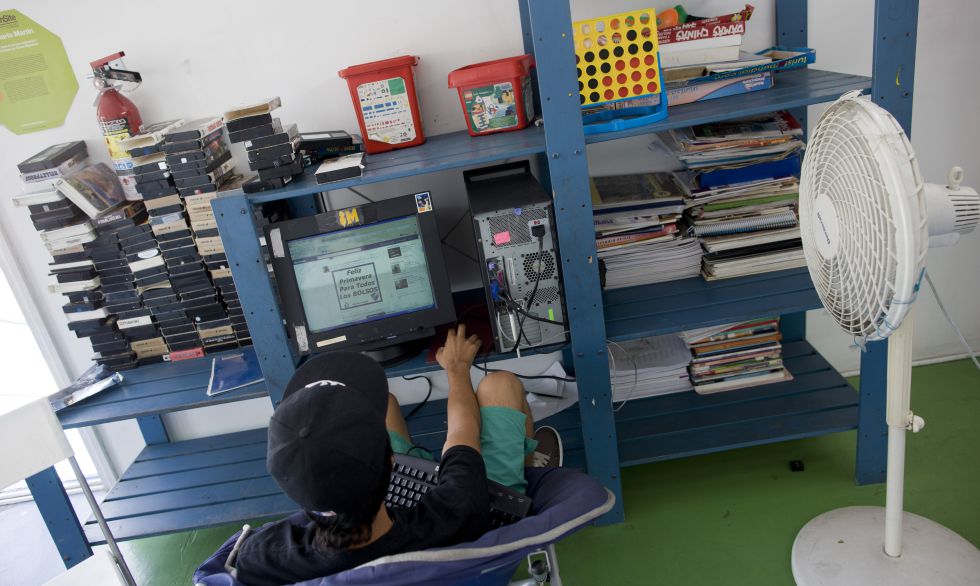A few days ago Mark and I visited two Tijuana shelters which provide temporary housing for migrants waiting to cross the border. Most of the migrants we met arrived here last month along with the caravan of 5,000 people who traveled from from Central America (through Honduras, Guatemala and Mexico).
First we went to Casa YMCA (we did not take photos, but these images are taken from Elpais.com).

(By the way, in Spanish this is pronounced EEM-KUH, get it? For the first half hour we were like, “Why is it called the Inca house?” Oh, duh. Got it.)
Right now 37 minors are living here temporarily as they await their chance to apply for refugee asylum in the US. They are almost all from Honduras, but also a couple from El Salvador, Costa Rica, and other parts of Mexico. There are only five girls and the rest are boys, ranging between the ages of 12-17. Before they arrived at Casa YMCA, they were all travelling unaccompanied, some having lost their parents to violence in their home country.
When we arrived with donations clothes and shoes, purchased by Mark and gathered by his sister Heather, the guy in charge offered to show us around and talked with us for about an hour. His name was Maynor and he was an extremely nice, fast talking man, utterly dedicated to taking care of these young people. Day and night there are always chaperones there (usually several adults) watching over the minors and running the shelter. But a big part of Maynor’s job is arranging every minor’s exit plan. Sometimes he facilitates a family reunification when a youth has been deported and is trying to get back to his or her families in other parts of Mexico or even other countries. This can include chaperoning them on flights back to their hometowns. But in general, most of them are awaiting the refugee asylum processing in the US, and every week boys and girls are sent across the border to the US.
Meanwhile, they wait here in Tijuana. Usually the boys and girls are allowed to come and go during the day, but last week there was a terrible tragedy when three boys were walking to visit friends in another part of town. They were attacked and attempted to be kidnapped. Two were murdered, the third escaped and is seriously injured. We saw a memorial for the boys while were there, with photos and flowers.
Maynor talked to us about how migrant youth are targeted by criminal organizations frequently, and shared with us specific stories about extortion and assault by those that traveled with the caravan. But those who arrived in Tijuana were lucky, because migrant murder and kidnapping is actually a real concern as they travel through Mexico. For example, there is a documented case last month of at least 100 others from this very caravan who were kidnapped in southern Mexico. This article also sheds light the problem. Anyway, at Casa YMCA security has increased and no one is allowed in the compound unless authorized. And currently the young residents are on lock-down and no one is allowed out.
Even so, while we were there the mood was fairly upbeat. We arrived during lunch, and they had full plates in front of them. The teenagers thanked us for the shoes and clothes, and Maynor explained how the YMCA worked. This shelter is funded completely by private donations—they are not a religious or government organization. Individuals and humanitarian groups regularly provide food, goods and services that keep this shelter open. The young residents get three meals a day, but they have to choose just one side dish and one beverage with each meal—it’s not a free-for-all/all-you-can-eat kind of deal. During the week they have doctors, psychologists, and lawyers that come through, and all the teens get appointments for everything from receiving cough medicine to filling out their applications for entry to the US.
The lawyers prioritize them by age…the ones close to turning 18 are the most urgent, because once they are no longer minors, it becomes much harder for them to qualify for asylum. Last week eight boys got processed and are now on “the other side.” This happens every week. Maynor confirmed that it’s not easy, but almost every minor who applies for asylum status eventually gets processed and sent across the border. The way it works is first they wait at a detention center in the US for at least several weeks. If they have family to stay with in the US, they are eventually transferred to them, but otherwise they have to stay at the detention center to wait for a match with a foster family or sponsor organization. However, even out of the detention center, they still must await the court process to determine if they will be granted permanent asylum. The director estimated that they will wait for at least eight months for their court date, and about 3 out of 10 are eventually granted asylum. The rest are denied and sent back to their home country, usually by plane.
Since the caravans started last spring, the Casa YMCA has been over capacity (nearly double) but has still never had to turn anyone away. The game room has been converted into an extra sleeping area, and boys were lounging on sleeping bags, without beds.

The game room overlooks the city of Tijuana and the US beyond the wall
While we were there a humanitarian group from LA arrived with a truck full of mattresses, so starting tonight everyone would have at least a mattress. The other dorm rooms were all full of bunk beds.
Besides the bedrooms, there is a small living room with a large-screen TV, two computers, and an outdoor area used for workshops, talks, and other projects.

It’s a very small space for so many teenagers to live together. On Sundays they go to a nearby soccer field and do martial arts (self-defense), and then play football (americano) or soccer.
The lasting impression I have of Casa YMCA was how young these boys seemed. I expected older teenagers, who had been toughened by the travel and by now had learned the ways of the streets. But instead I was struck by how young, vulnerable, and sweet they appeared. Very smiley and playful, not yet hardened by their journey. Well, at least not on the outside. Maynor talked about the emotional difficulties many of them have from the stress, uncertainty and circumstances of being so far away from their families. This is one of the things the Casa tries to help them with on a daily basis.
*****
Next we went to the Centro Madre Assunta, a catholic convent that has been providing shelter for women and children migrants for many years. There we met Sister Salome, who was a wealth of information.

She was happy to receive the clothing we brought for the women, and then took us into her office to chat with us about this shelter’s history. Sister Salome first talked about the mass migration of the Haitians, who started coming to Tijuana five years ago. After the Haiti earthquake in 2010, many Haitians were received by Brazil, but as the Brazilian economy faltered, they found that they could not make a good living there. When they learned that they could apply for refugee status in the US, many made the very long, arduous five-thousand mile journey by bus from Brazil to Tijuana. Here’s a good article about it.

Anyway, for awhile they could apply refugee asylum, but in September 2016 the US halted the asylum program and many got stuck in Tijuana, with the threat of being deported directly back to Haiti if they tried to apply for asylum. A large group of Haitians decided Tijuana was better, and now there are estimated 4,000 Haitians living in TJ. They have work permits, are integrated into the community, and two dozen are enrolled at the university. There is even a new neighborhood called “Little Haiti.” I asked her if that is happening now with those from Central America as well. Do they want to stay in Mexico, too? She said no. She said they all aspire to become American, sooner or later.
Currently there are over 100 mothers and children living at the Centro Madre Assunta, a facility that has an official capacity of 44. It was clearly brimming with people while we were there, but again, the mood was jubilant. It was just days before Christmas, and we saw many donations being carried through the door. The sisters and residents were busy preparing pinatas and food for tomorrow’s posada.
Here’s the migrant process for women and their children, explained to us by Sister Salome. She stressed that each case is different. Most women and children currently staying there arrived more than a month ago. Each went to the border to “take a number” at the San Ysidro Port of Entry at Chaparral. They did this by putting their names down on a list in a notebook. Everyday about 80 numbers are called, and right now the wait is taking about four weeks. This article sums it well—but it’s pretty remarkable that this list is maintained by a small team of migrants themselves (not the US or Mexican authorities).
Sister Salome described how the women are constantly monitoring the list and sharing information with each other at the shelter. When your number is close, you need to go to the border everyday to wait for yours to be called, along with your children and documents ready. Once your number is called, you get picked up by a bus and driven across the border, where you stay at the detention center for around three days while you are processed. You have to fill out forms that document many things, including your statement showing credible fear of returning to your home country. If you pass the credible fear test and present all your documents, you will most likely get to the next step: you are released into the US, but under vigilance. Sister Salome mentioned that many migrant women are released with electronic security anklets. They also have to provide the address they will be living (often with family in the US), and they are restricted from travelling too far a radius from that address. Then they have to maintain contact with the courts and attend their court date whenever it is scheduled. This could be several months to years, depending on each case.
Some of the women who are released after detention don’t have anywhere to go, so that’s when they go to a similar migrant shelter on the US side of the border, like one at a church in Chula Vista where many of Sister Salome’s residents have ended up. From there they are assisted to get their things organized. Some contact family members in different parts of the US who send them an airline ticket; none are permitted to work to support themselves while they are in process, unless 180 days have passed without a decision. So for the first six months, all they can really do is wait for their court date. The big question we asked was this: once they get their court date, how many are allowed to stay? Sister Salome admitted she didn’t know the exact answer, but said, “They say only one or two out of a hundred get to stay.” This article, this one, and this one as well suggest the odds are similar, if not slightly better.
I wondered aloud how many migrants just go under the radar after they leave the detention center, and fail to attend their court date. Sister Salome didn’t know the answer to this, so I spent some time researching it this weekend. It appears that asylum applicants (as compared to deportees or those apprehended crossing illegally) have a higher rate of staying in the system and honoring their court dates, especially if measures like electronic anklets are in place.
I spent a lot of time reading through US Justice Department data. Looking at the statistics from last year (2017), here are the numbers for Asylum Cases. Keep in mind that this is just affirmative asylum cases, not immigration cases for students, unaccompanied minors, deportees, those arrested crossing illegally, etc. For this group in 2017, there were 52,871 cases reviewed. Most of the cases were postponed or the applicants withdrew their requests, so no decision was made. But of the cases decided, 10,690 were granted asylum and 17,718 were denied. Once denied, the migrant is removed from the US, i.e. deported. 4,599 of those denied were ordered to be removed in absentia (which means that 4,599 didn’t show up for their court date).
So this statistic might be helpful: 28,408 had court dates and only 23,809 showed up for those court dates. Which means that 16% were no-shows last year. The year before, the no-show number was similar: 14.2%. What I gather from that is that yes, some people are getting into the country in a legal way but then not following through with the law, but it’s a small number that is negligible compared to all the 652,006 immigration cases pending in 2017. And due to the major backlog of case review, the only alternatives I can see are to either house asylum applicants for months to years in detention centers, or deny them straight away at the port of entry and send them back to their home countries immediately. I don’t think these options make sense. So my summation is that the current system for refugee asylum applicants makes sense.
But let’s get back to the shelter in Mexico. Waiting in the Tijuana shelter is hard for the women and families. Sister Salome told us some stories about how the women and children pass the time. Most have cell phones and use the free WIFI to communicate with their families via Whatsapp. She laughed at how the women come running to her when the wifi is down, desperate for her to fix it. There is also classroom for the children from 9-4 each day. The children are so excited to see the teacher, and love going to “school.”
We asked her a question that many might wonder: “Didn’t all these women know how hard this journey would be? Didn’t they hear on the news about the violence against migrants in Mexico, the anti-migrant politics by Trump? And how could they not expect these long, arduous waits just to get processed, when they were travelling with 5,000 migrants all going to the same border gate?” Sister Salome nodded and said, “I believe that many of them were suffering so much in their situations from violence, political instability, and general insecurity that they allowed themselves to be blinded from reality. Thus, they came here just hoping for the best, against all odds.”
I tried to imagine living in a place where you cannot trust the police or the government, and you feared for your safety and your children’s futures. And then I thought about the legendary American Dream, a notion that is still alive and well in most of the world. I could see how these women would let themselves skim over the news about Trump and the low rates of asylum acceptance, and think, ‘America is where everyone goes who wants a better life. It’s been that way more than a hundred years. This is my best option.’ And with that hope, and that risky logic, these people have traveled thousands of miles to gamble on America. The odds are against them completely, and many will probably have to return to their home countries, or settle for building a new life in Mexico, but perhaps it was still worth the risk? It depends how much risk you can tolerate, but if I were them, I’d probably be waiting in a migrant shelter right now, too.




